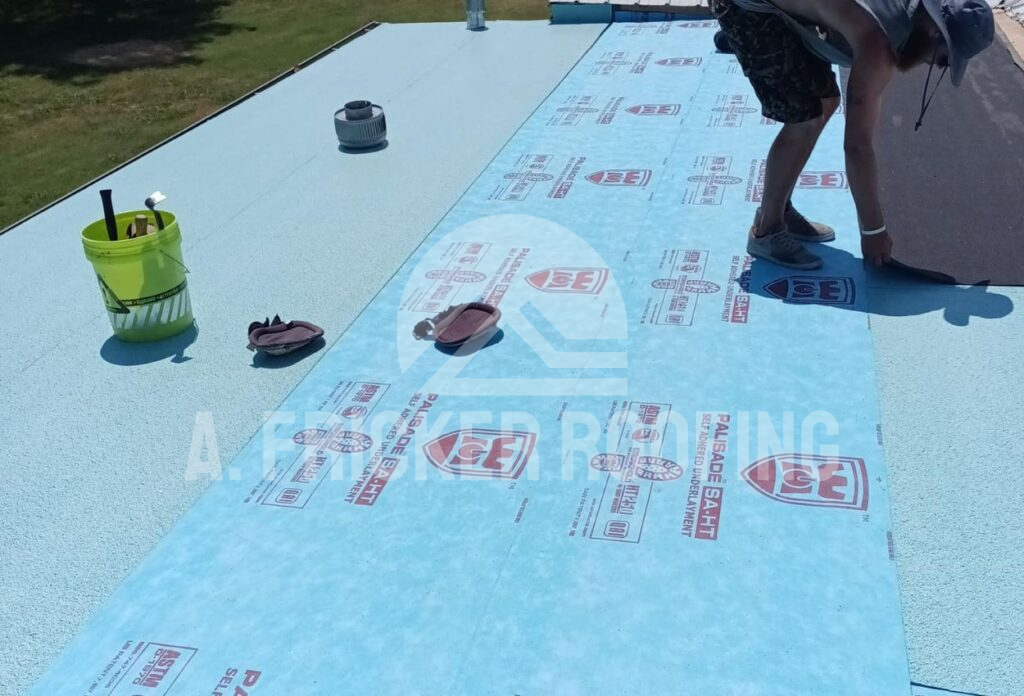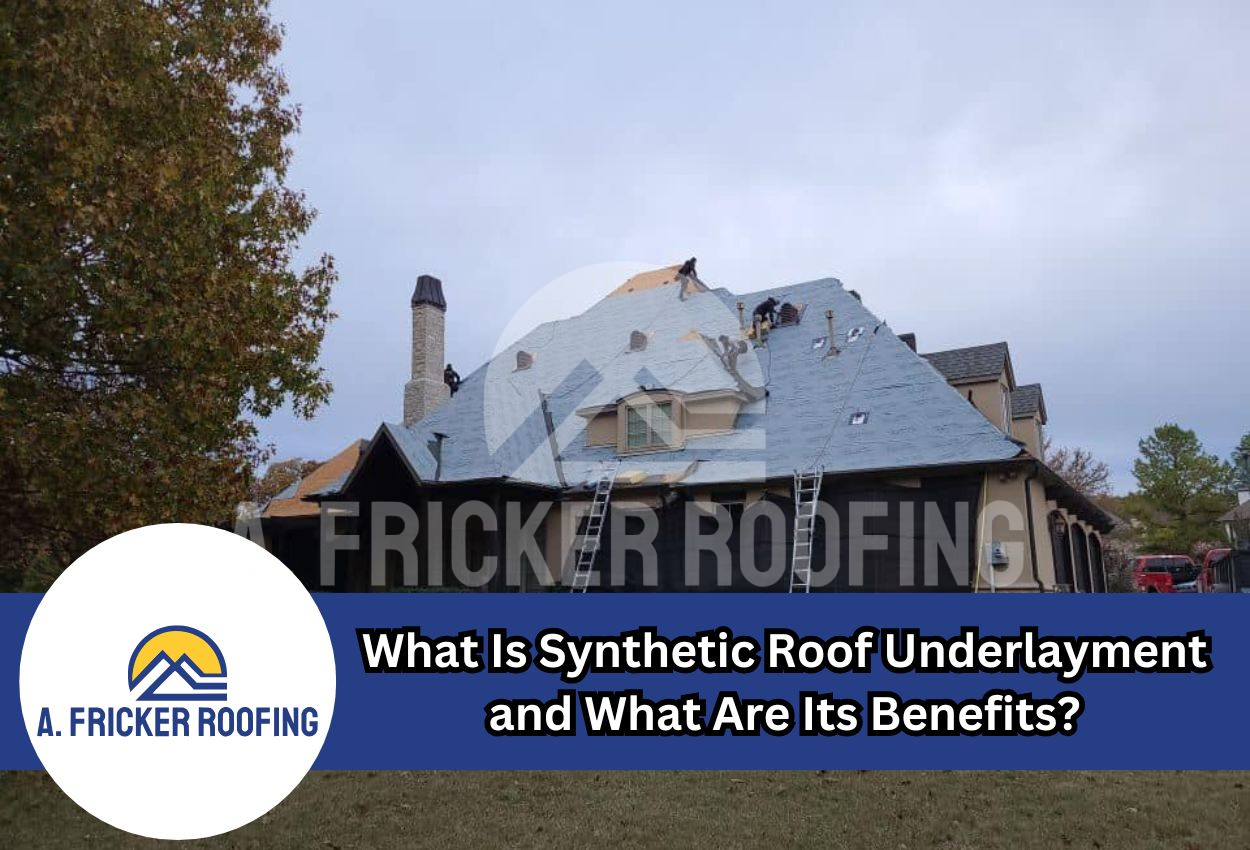If you’re planning to install or replace your new roof there are several things to consider beyond just the type of roofing material. One crucial component of your roof is the underlayment.
This is the layer that is installed just beneath the shingles or another type of roofing material, responsible for protecting the roof deck and interior from water damage.
When you start to look at your options you will find that synthetic roofing underlayment is one of the most sought-after types of underlayment on the market. If you are also searching for the right type of underlayment for your needs, and want to understand what synthetic roof underlayment is, you are in the right place.
What Is Synthetic Roof Underlayment?

Synthetic roof underlayment is a protective layer that sits between your roof deck (the base structure) and the shingles or roofing material you see on the outside.
As the word suggests, instead of using natural materials, synthetic underlayment uses advanced, man-made polymers, like polypropylene or polyethylene. These are woven together to form a durable sheet that creates an underlayment that remains lightweight, yet durable.
Roofing Felt vs. Synthetic Underlayment:
In the past, roofing felt, also known as tar paper, was the standard choice for underlayment. While it worked reasonably well, it had notable flaws such as being prone to tearing, wrinkling when wet, and absorbing moisture, which could quickly lead to mold and damage on the roof.
Synthetic underlayment has since emerged as a distinct alternative, designed for better performance. Made from advanced polymers, it offers superior durability, water resistance, and UV protection. Synthetic options are also lightweight and easier to install, making them the go-to choice for most roofing projects today.
Overall, synthetic underlayment is a newer advancement in the industry that has gained an excellent reputation. It’s become the go-to choice for homeowners and roofing professionals, and for good reason.
To learn more about the difference between synthetic underlayment and roofing felt, check out our blog post here: Synthetic Underlayment vs. Felt Underlayment: Which is Right for Your Roof?
Benefits of Synthetic Roof Underlayment
So why is synthetic underlayment such a game-changer in the roofing industry? Here’s a closer look at its key advantages:
Superior Durability
Synthetic roof underlayment is engineered to withstand wear and tear, whether from foot traffic during installation or harsh weather conditions later on. Unlike traditional felt, which can rip or degrade over time, synthetic materials are created to resist tearing, stretching, or cracking. This durability means worrying less about the integrity of your roof’s foundation.
Lighter Than Traditional Underlayments
Traditional felt underlayment can be heavy to install, while synthetic underlayment is lightweight and easy to roll out. This simplicity allows roofing professionals to work more efficiently, saving time and money by reducing labor costs. Since the underlayment is lighter, it also reduces stress on the structure of the roof, which is beneficial for long-term performance.
Weather Protection During Installation
Roofing projects aren’t normally completed in a day, and unpredictable weather can cause delays. If your roof deck is left exposed for some time before work can resume, then synthetic underlayment is a good choice as it serves as a temporary shield, protecting your roof deck from rain, snow, or UV rays during construction.
Most synthetic underlayment is created to handle UV exposure for extended periods, commonly 60 to 90 days, without breaking down or losing effectiveness. With synthetic underlayment, you may experience enhanced peace of mind knowing that your roof will be protected in the instance that Mother Nature doesn’t cooperate, or the project takes longer than expected.
Compatibility with Modern Roofing Systems
Roofing materials have come a long way over the years and gone are the days when asphalt shingles were your only option. Today, you’ll find more durable and appealing roofing materials to choose from, and synthetic underlayment works seamlessly with each of them!
Whether you’re installing asphalt shingles, metal panels, or even tile, synthetic underlayment provides a strong, reliable base that enhances the performance of your roof. Its versatility makes it the perfect choice for any home or project.
Synthetic Roofing Underlayments Are Slip Resistant
Working on a roof can be risky, especially on steep slopes or in wet conditions. The combination of steep slopes, unpredictable weather, and limited footing makes safety a top priority for roofing professionals. That’s why synthetic underlayment stands out. Most synthetic underlayments today are manufactured with advanced slip-resistant technology built right into the material. This typically involves making one side of the underlayment textured or coated surface that enhances traction, even in less-than-ideal conditions, such as after a light drizzle or on dew-filled mornings.
For homeowners, this means the team working on your roof can get the job done efficiently and with a lower risk of accidents.
Longevity
When it comes to roofing systems, durability and lifespan are critical, and you get both with a synthetic underlayment. On average, synthetic underlayment can last between 25 to 30 years, depending on the specific product being used and local weather conditions.
Problems with Synthetic Roof Underlayment
Synthetic underlayments are a great option to consider for your roof replacement project, but unfortunately, like every other part of the roof, it has some limitations. Here are some of the problems with synthetic underlayment.
Higher Cost
One of the most notable drawbacks of synthetic underlayment is that it’s more expensive than both traditional felt and other types of underlayment. While the long-term savings often outweigh the original cost, homeowners on a tight budget may not find comfort in this, especially when all the other costs involved with a roofing project add up. Balancing costs and benefits is essential when choosing materials.
Brand Variations
The quality of the synthetic underlayment varies significantly between brands. While top-tier products offer excellent performance and durability, cheaper options may lack the same reliability. It’s vital to work with a professional roofing company to select a trusted brand that meets your specific needs and local weather conditions.
Some Areas (May) Require Felt
In certain regions, building codes or specific roof designs may mandate the use of felt underlayment. This could be due to historical standards or architectural requirements, limiting your options. Before choosing synthetic underlayment, ensure it complies with local building codes to avoid complications.
To learn more about the problems with synthetic roof underlayment, and how it can affect your roof replacement project, check out our comprehensive blog post. Let’s make sure your roof is built to last!
Which Is The Best Synthetic Underlayment?
Synthetic roof underlayment is an innovation that offers exceptional protection, durability, and ease of installation, making it a top choice for modern roofing systems. When you pair it with the right shingles whether it’s budget-friendly asphalt, or sleek metal, you’ve got a roofing system built to last.
If you want to replace your roofing system you need to put the trust in the experts at A. Fricker Roofing and Waterproofing. Our team has years of experience in roof replacement and repairs. From underlayment to roofing shingles, we use roofing products from leading manufacturers.
As a roofing company, we’re here to ensure your roof stands strong through every season. Have questions or want to explore your options? Contact us today at (918) 402-7167 to speak with one of our experts who will be happy to help.
FAQ’s
A.Synthetic underlayment is typically made from polymers such as polypropylene or polyethylene. These materials are engineered to provide excellent durability, water resistance, and UV protection while being lightweight and easy to handle.
A.Synthetic underlayment generally offers superior performance compared to felt. It is more durable, tear-resistant, water-repellent, and can withstand longer UV exposure. While it costs more upfront, its longevity and effectiveness often make it a better long-term investment.

